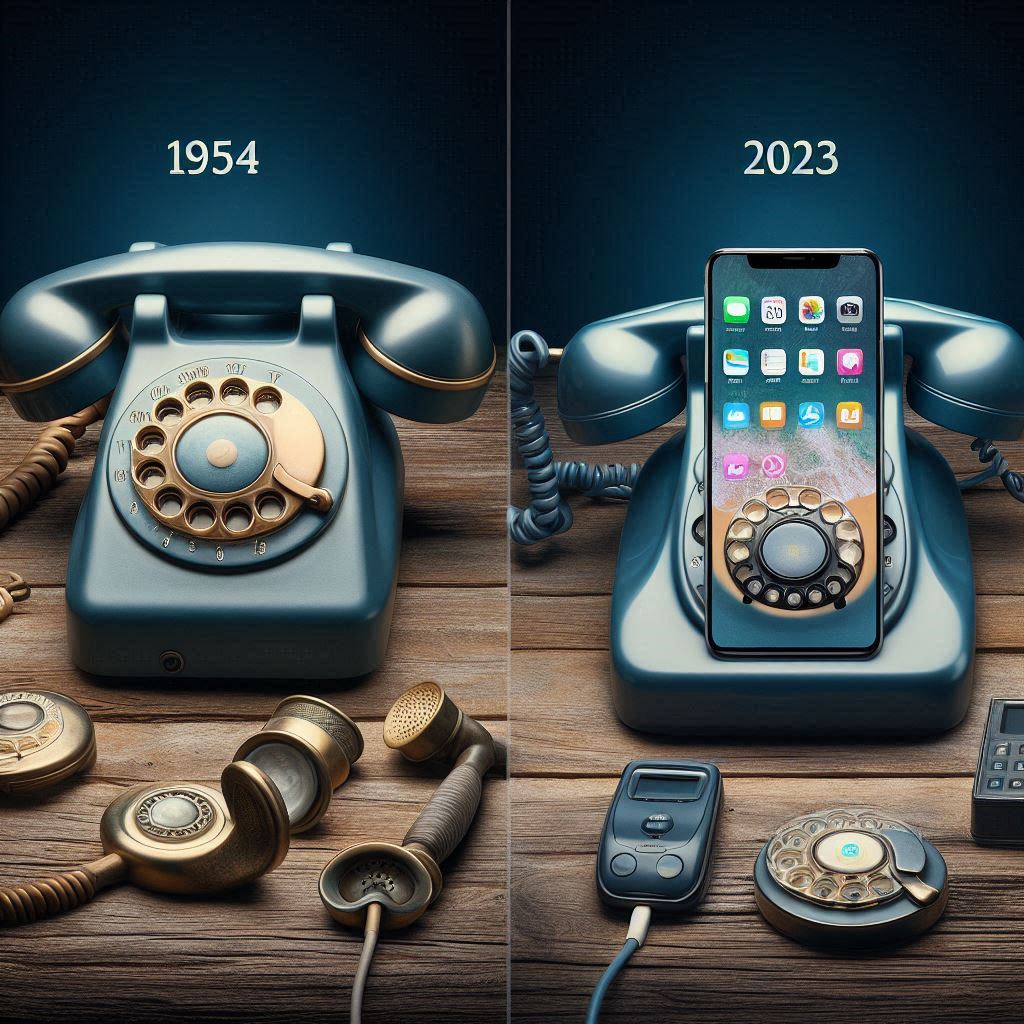The span between 1954 and 2023 marks a period of extraordinary technological and societal change. In just under seven decades, the world has transformed in ways that were unimaginable to those living in the mid-20th century. By comparing the innovations and societal shifts of these two years, we can gain a deeper understanding of how far humanity has come and where it might be headed.
The World in 1954
1954 was a year that saw the world in the midst of the Cold War, with tensions between the United States and the Soviet Union defining global politics. This period was marked by the fear of nuclear conflict, but it was also a time of rapid technological advancement and the beginnings of what would become the digital age.
Technology and Innovation:
In 1954, technology was in its infancy compared to today’s standards. The first practical transistor radios were just being introduced, marking the beginning of portable consumer electronics. Computers were massive machines that occupied entire rooms, and their capabilities were limited to basic calculations. The idea of a personal computer, let alone a smartphone, was the stuff of science fiction.
Television was becoming a staple in American households, bringing news and entertainment into living rooms across the country. In transportation, the jet age was dawning, with the first commercial jet airliner, the Boeing 707, soon to enter service. Meanwhile, automotive technology was focused on improving comfort and speed, with car culture becoming a defining aspect of the era.
Society and Culture:
The 1950s were characterized by a post-war boom in the United States and other parts of the Western world. The economy was thriving, and there was a strong sense of optimism about the future. Suburbanization was in full swing, with millions of families moving to newly built suburbs, where they embraced the ideals of the “American Dream.”
However, this period was also marked by social conservatism and rigid gender roles. The civil rights movement was gaining momentum, but racial segregation and discrimination were still deeply entrenched in society. Women were largely expected to fulfill domestic roles, and the idea of a career woman was not widely accepted.
Global Perspective:
On a global scale, 1954 was a year of decolonization and the reconfiguration of political power. Countries in Asia and Africa were beginning to gain independence from European colonial powers, setting the stage for a new world order. This year also saw the beginning of the Vietnam War, a conflict that would have profound consequences for the United States and Southeast Asia.
The World in 2023
Fast forward to 2023, and the world is nearly unrecognizable from what it was in 1954. The technological, social, and political landscapes have shifted dramatically, driven by the rapid pace of innovation and globalization.
Technology and Innovation:
By 2023, technology has permeated every aspect of daily life. Smartphones, which are more powerful than the computers that sent astronauts to the moon, are ubiquitous. The internet, a concept that didn’t exist in 1954, has revolutionized how we communicate, work, and entertain ourselves. Social media platforms connect billions of people across the globe, creating a digital society that transcends national borders.
Artificial intelligence (AI) and machine learning are at the forefront of technological innovation, powering everything from virtual assistants to autonomous vehicles. The promise of AI is both exciting and daunting, as it holds the potential to solve complex problems but also raises ethical concerns about privacy, employment, and security.
In healthcare, advancements in biotechnology have led to groundbreaking treatments and the possibility of extending human lifespan. The use of CRISPR technology for gene editing has opened new frontiers in medicine, offering the potential to cure genetic diseases.
Society and Culture:
The social fabric of 2023 is vastly different from that of 1954. Gender roles have evolved, with women making significant strides in the workforce and in leadership positions. The fight for racial equality has seen progress, though challenges remain. The LGBTQ+ rights movement has also gained significant ground, with many countries recognizing same-sex marriage and enacting anti-discrimination laws.
Culturally, the world is more interconnected than ever before. The internet has facilitated the exchange of ideas, art, and entertainment across borders, creating a global culture that is both diverse and unified. However, this interconnectedness has also led to cultural clashes and debates about identity, globalization, and the preservation of local traditions.
Global Perspective:
In 2023, the geopolitical landscape is shaped by new powers and challenges. The United States and China are engaged in a complex relationship that blends competition with cooperation. Issues such as climate change, cybersecurity, and pandemics require global collaboration, underscoring the interdependence of nations.
The world is also grappling with the consequences of climate change, with extreme weather events becoming more frequent and severe. The push for sustainable development and renewable energy is at the forefront of international policy, as nations strive to mitigate the impact of global warming.
The Journey from 1954 to 2023
The journey from 1954 to 2023 is a testament to human ingenuity and resilience. The technological advances made during this period have transformed society, creating new opportunities and challenges. Social progress has been significant, though the path has been fraught with struggles and setbacks.
As we look ahead, the lessons of the past seven decades remind us that change is constant and that the future will be shaped by the innovations and decisions of today. The comparison between 1954 and 2023 offers a powerful reflection on how far we have come and the potential that lies ahead.
